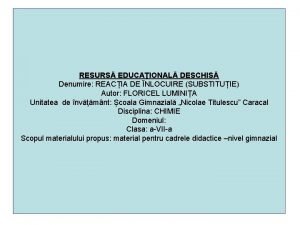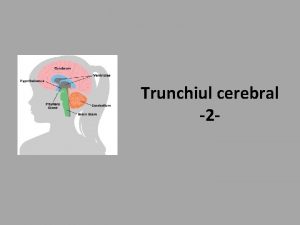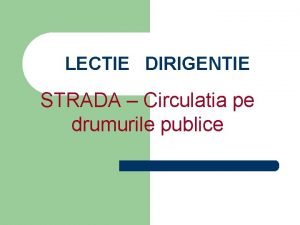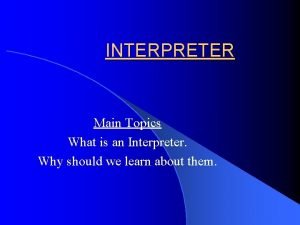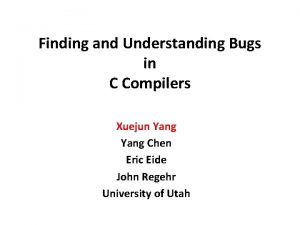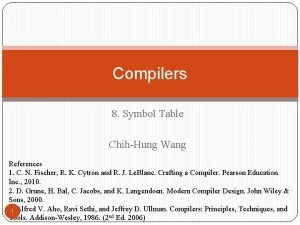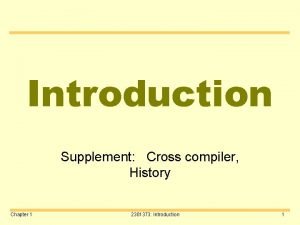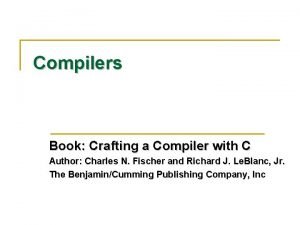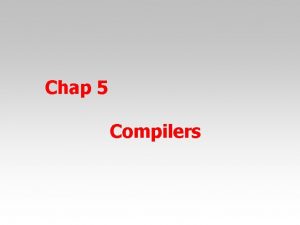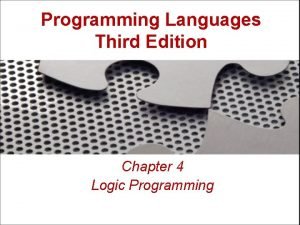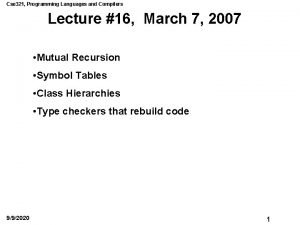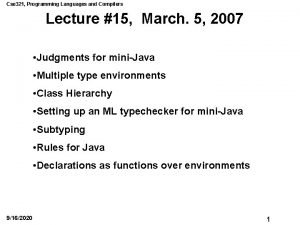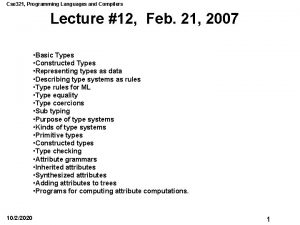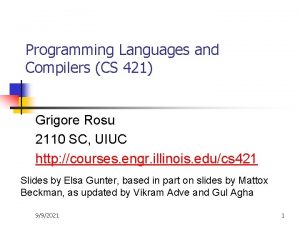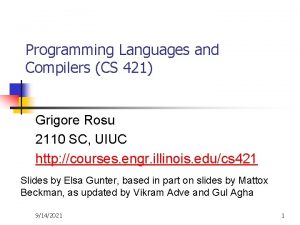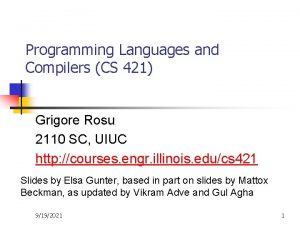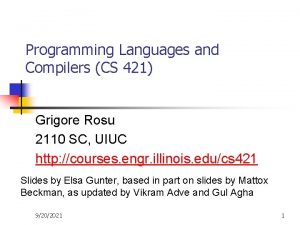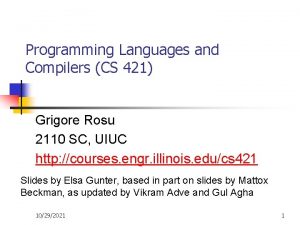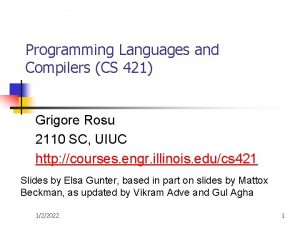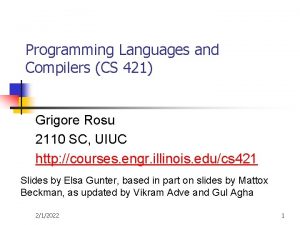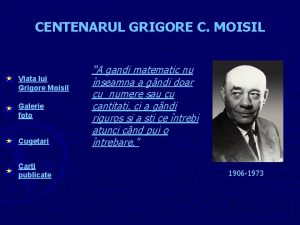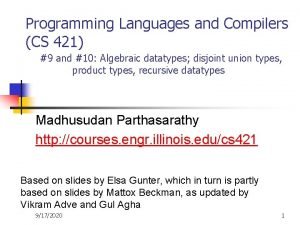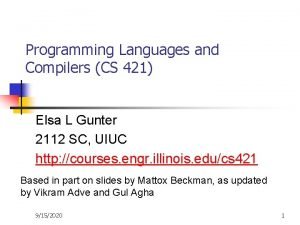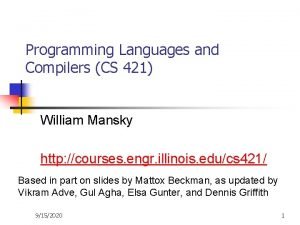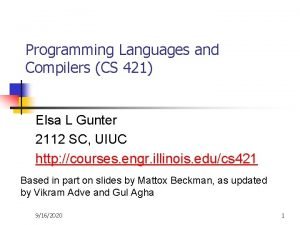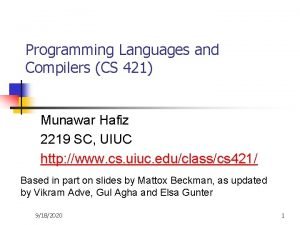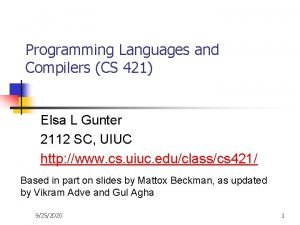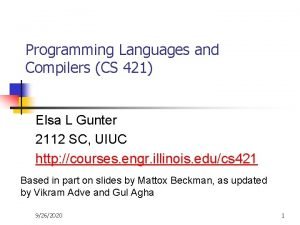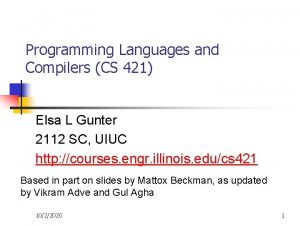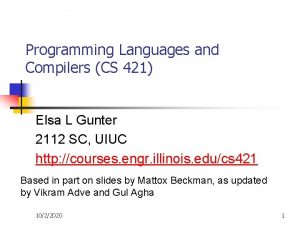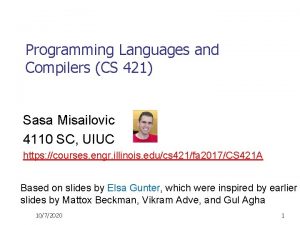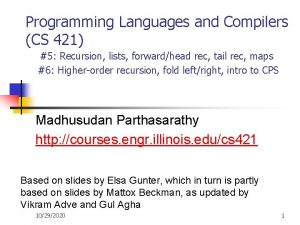Programming Languages and Compilers CS 421 Grigore Rosu





























![Let in Command (E, m) v (C, m[I<-v]) m’ (let I = E in Let in Command (E, m) v (C, m[I<-v]) m’ (let I = E in](https://slidetodoc.com/presentation_image/ecda9bd1f13605d6dcadb41a239f7fd5/image-30.jpg)








- Slides: 38

Programming Languages and Compilers (CS 421) Grigore Rosu 2110 SC, UIUC http: //courses. engr. illinois. edu/cs 421 Slides by Elsa Gunter, based in part on slides by Mattox Beckman, as updated by Vikram Adve and Gul Agha 9/18/2020 1

Semantics Expresses the meaning of syntax n Static semantics n Meaning based only on the form of the expression without executing it n Usually restricted to type checking / type inference n 9/18/2020 2

Dynamic semantics Method of describing meaning of executing a program n Several different types: n Operational Semantics n Axiomatic Semantics n Denotational Semantics n 9/18/2020 3

Dynamic Semantics Different languages better suited to different types of semantics n Different types of semantics serve different purposes n 9/18/2020 4

Operational Semantics n n Start with a simple notion of machine Describe how to execute (implement) programs of language on virtual machine, by describing how to execute each program statement (ie, following the structure of the program) Meaning of program is how its execution changes the state of the machine Useful as basis for implementations 9/18/2020 5

Axiomatic Semantics Also called Floyd-Hoare Logic n Based on formal logic (first order predicate calculus) n Axiomatic Semantics is a logical system built from axioms and inference rules n Mainly suited to simple imperative programming languages n 9/18/2020 6

Axiomatic Semantics n n n Used to formally prove a property (post-condition) of the state (the values of the program variables) after the execution of program, assuming another property (pre-condition) of the state before execution Written : {Precondition} Program {Postcondition} Source of idea of loop invariant 9/18/2020 7

Denotational Semantics n n Construct a function M assigning a mathematical meaning to each program construct Lambda calculus often used as the range of the meaning function Meaning function is compositional: meaning of construct built from meaning of parts Useful for proving properties of programs 9/18/2020 8

Natural Semantics n n n Aka Structural Operational Semantics, aka “Big Step Semantics” Provide value for a program by rules and derivations, similar to type derivations Rule conclusions look like (C, m) m’ or (E, m) v 9/18/2020 9

Simple Imperative Programming Language n n n I Identifiers N Numerals B : : = true | false | B & B | B or B | not B |E<E|E=E E: : = N | I | E + E | E * E | E - E | - E C: : = skip | C; C | I : : = E | if B then C else C fi | while B do C od 9/18/2020 10

Natural Semantics of Atomic Expressions Identifiers: (I, m) m(I) n Numerals are values: (N, m) N n Booleans: (true, m) true (false , m) false n 9/18/2020 11

Booleans: (B, m) false (B, m) true (B’, m) b (B & B’, m) false (B & B’, m) b (B, m) true (B or B’, m) true (B, m) false (B’, m) b (B or B’, m) b (B, m) true (not B, m) false 9/18/2020 (B, m) false (not B, m) true 12

Relations (E, m) U n n (E’, m) V U ~ V = b (E ~ E’, m) b By U ~ V = b, we mean does (the meaning of) the relation ~ hold on the meaning of U and V May be specified by a mathematical expression/equation or rules matching U and V 9/18/2020 13

Arithmetic Expressions (E, m) U (E’, m) V U op V = N (E op E’, m) N where N is the specified value for U op V 9/18/2020 14

Commands Skip: Assignment: Sequencing: 9/18/2020 (skip, m) m (E, m) V (I: : =E, m) m[I <-- V ] (C, m) m’ (C’, m’) m’’ (C; C’, m) m’’ 15

If Then Else Command (B, m) true (C, m) m’ (if B then C else C’ fi, m) m’ (B, m) false (C’, m) m’ (if B then C else C’ fi, m) m’ 9/18/2020 16

While Command (B, m) false (while B do C od, m) m (B, m) true (C, m) m’ (while B do C od, m’ ) m’’ (while B do C od, m) m’’ 9/18/2020 17

Example: If Then Else Rule (2, {x->7}) 2 (3, {x->7}) 3 (2+3, {x->7}) 5 (x, {x->7}) 7 (5, {x->7}) 5 (y: = 2 + 3, {x-> 7} (x > 5, {x -> 7}) true {x- >7, y->5} (if x > 5 then y: = 2 + 3 else y: =3 + 4 fi, {x -> 7}) ? 9/18/2020 18

Example: If Then Else Rule (2, {x->7}) 2 (3, {x->7}) 3 (2+3, {x->7}) 5 (x, {x->7}) 7 (5, {x->7}) 5 (y: = 2 + 3, {x-> 7} (x > 5, {x -> 7}) ? {x- >7, y->5} (if x > 5 then y: = 2 + 3 else y: =3 + 4 fi, {x -> 7}) ? {x->7, y->5} 9/18/2020 19

Example: Arith Relation (2, {x->7}) 2 (3, {x->7}) 3 ? >? =? (2+3, {x->7}) 5 (x, {x->7}) ? (5, {x->7}) ? (y: = 2 + 3, {x-> 7} (x > 5, {x -> 7}) ? {x- >7, y->5} (if x > 5 then y: = 2 + 3 else y: =3 + 4 fi, {x -> 7}) ? {x->7, y->5} 9/18/2020 20

Example: Identifier(s) (2, {x->7}) 2 (3, {x->7}) 3 7 > 5 = true (2+3, {x->7}) 5 (x, {x->7}) 7 (5, {x->7}) 5 (y: = 2 + 3, {x-> 7} (x > 5, {x -> 7}) ? {x- >7, y->5} (if x > 5 then y: = 2 + 3 else y: =3 + 4 fi, {x -> 7}) ? {x->7, y->5} 9/18/2020 21

Example: Arith Relation (2, {x->7}) 2 (3, {x->7}) 3 7 > 5 = true (2+3, {x->7}) 5 (x, {x->7}) 7 (5, {x->7}) 5 (y: = 2 + 3, {x-> 7} (x > 5, {x -> 7}) true {x- >7, y->5} (if x > 5 then y: = 2 + 3 else y: =3 + 4 fi, {x -> 7}) ? {x->7, y->5} 9/18/2020 22

Example: If Then Else Rule (2, {x->7}) 2 (3, {x->7}) 3 7 > 5 = true (2+3, {x->7}) 5 (x, {x->7}) 7 (5, {x->7}) 5 (y: = 2 + 3, {x-> 7} (x > 5, {x -> 7}) true ? . (if x > 5 then y: = 2 + 3 else y: =3 + 4 fi, {x -> 7}) ? {x->7, y->5} 9/18/2020 23

Example: Assignment (2, {x->7}) 2 (3, {x->7}) 3 7 > 5 = true (2+3, {x->7}) ? (x, {x->7}) 7 (5, {x->7}) 5 (y: = 2 + 3, {x-> 7} (x > 5, {x -> 7}) true ? {x- >7, y->5} (if x > 5 then y: = 2 + 3 else y: =3 + 4 fi, {x -> 7}) ? {x->7, y->5} 9/18/2020 24

Example: Arith Op ? +? =? (2, {x->7}) ? (3, {x->7}) ? 7 > 5 = true (2+3, {x->7}) ? (x, {x->7}) 7 (5, {x->7}) 5 (y: = 2 + 3, {x-> 7} (x > 5, {x -> 7}) true ? . (if x > 5 then y: = 2 + 3 else y: =3 + 4 fi, {x -> 7}) ? {x->7, y->5} 9/18/2020 25

Example: Numerals 2+3=5 (2, {x->7}) 2 (3, {x->7}) 3 7 > 5 = true (2+3, {x->7}) ? (x, {x->7}) 7 (5, {x->7}) 5 (y: = 2 + 3, {x-> 7} (x > 5, {x -> 7}) true ? {x->7, y->5} (if x > 5 then y: = 2 + 3 else y: =3 + 4 fi, {x -> 7}) ? {x->7, y->5} 9/18/2020 26

Example: Arith Op 2+3=5 (2, {x->7}) 2 (3, {x->7}) 3 7 > 5 = true (2+3, {x->7}) 5 (x, {x->7}) 7 (5, {x->7}) 5 (y: = 2 + 3, {x-> 7} (x > 5, {x -> 7}) true ? {x->7, y->5} (if x > 5 then y: = 2 + 3 else y: =3 + 4 fi, {x -> 7}) ? {x->7, y->5} 9/18/2020 27

Example: Assignment 2+3=5 (2, {x->7}) 2 (3, {x->7}) 3 7 > 5 = true (2+3, {x->7}) 5 (x, {x->7}) 7 (5, {x->7}) 5 (y: = 2 + 3, {x-> 7} (x > 5, {x -> 7}) true {x->7, y->5} (if x > 5 then y: = 2 + 3 else y: =3 + 4 fi, {x -> 7}) ? {x->7, y->5} 9/18/2020 28

Example: If Then Else Rule 2+3=5 (2, {x->7}) 2 (3, {x->7}) 3 7 > 5 = true (2+3, {x->7}) 5 (x, {x->7}) 7 (5, {x->7}) 5 (y: = 2 + 3, {x-> 7} (x > 5, {x -> 7}) true {x->7, y->5} (if x > 5 then y: = 2 + 3 else y: =3 + 4 fi, {x -> 7}) {x->7, y->5} 9/18/2020 29
![Let in Command E m v C mIv m let I E in Let in Command (E, m) v (C, m[I<-v]) m’ (let I = E in](https://slidetodoc.com/presentation_image/ecda9bd1f13605d6dcadb41a239f7fd5/image-30.jpg)
Let in Command (E, m) v (C, m[I<-v]) m’ (let I = E in C, m) m’ ’ Where m’’ (y) = m’ (y) for y I and m’’ (I) = m (I) if m(I) is defined, and m’’ (I) is undefined otherwise 9/18/2020 30

Example (x, {x->5}) 5 (3, {x->5}) 3 (x+3, {x->5}) 8 (5, {x->17}) 5 (x: =x+3, {x->5}) {x->8} (let x = 5 in (x: =x+3), {x -> 17}) ? 9/18/2020 31

Example (x, {x->5}) 5 (3, {x->5}) 3 (x+3, {x->5}) 8 (5, {x->17}) 5 (x: =x+3, {x->5}) {x->8} (let x = 5 in (x: =x+3), {x -> 17}) {x->17} 9/18/2020 32

Comment n n n Simple Imperative Programming Language introduces variables implicitly through assignment The let-in command introduces scoped variables explictly Clash of constructs apparent in awkward semantics 9/18/2020 33

Interpretation Versus Compilation n A compiler from language L 1 to language L 2 is a program that takes an L 1 program and for each piece of code in L 1 generates a piece of code in L 2 of same meaning An interpreter of L 1 in L 2 is an L 2 program that executes the meaning of a given L 1 program Compiler would examine the body of a loop once; an interpreter would examine it every time the loop was executed 9/18/2020 34

Interpreter n n An Interpreter represents the operational semantics of a language L 1 (source language) in the language of implementation L 2 (target language) Built incrementally n n n Start with literals Variables Primitive operations Evaluation of expressions Evaluation of commands/declarations 9/18/2020 35

Interpreter n Takes abstract syntax trees as input n n One procedure for each syntactic category (nonterminal) n n n In simple cases could be just strings eg one for expressions, another for commands If Natural semantics used, tells how to compute final value from code If Transition semantics used, tells how to compute next “state” n To get final value, put in a loop 9/18/2020 36

Natural Semantics Example n n compute_exp (Var(v), m) = look_up v m compute_exp (Int(n), _) = Num (n) … compute_com(If. Exp(b, c 1, c 2), m) = if compute_exp (b, m) = Bool(true) then compute_com (c 1, m) else compute_com (c 2, m) 9/18/2020 37

Natural Semantics Example n n n compute_com(While(b, c), m) = if compute_exp (b, m) = Bool(false) then m else compute_com (While(b, c), compute_com(c, m)) May fail to terminate - exceed stack limits Returns no useful information then 9/18/2020 38
 Cs 421
Cs 421 Cs 421 programming languages and compilers
Cs 421 programming languages and compilers Grigore rosu
Grigore rosu Cuso4 denumire
Cuso4 denumire Castelul kornis-rákóczi-bethlen din iernut
Castelul kornis-rákóczi-bethlen din iernut Nuclei somatomotori
Nuclei somatomotori Muntele rosu rhododendron
Muntele rosu rhododendron Reguli de circulatie pentru pietoni si biciclisti
Reguli de circulatie pentru pietoni si biciclisti 1 martie in istorie
1 martie in istorie Pros and cons of compilers and interpreters
Pros and cons of compilers and interpreters Finding and understanding bugs in c compilers
Finding and understanding bugs in c compilers Compilers: principles, techniques, and tools
Compilers: principles, techniques, and tools Advantages and disadvantages of compiler and interpreter
Advantages and disadvantages of compiler and interpreter Real-time systems and programming languages
Real-time systems and programming languages Advantages of application software
Advantages of application software Real-time systems and programming languages
Real-time systems and programming languages C++ binarymove
C++ binarymove Cousins of compiler
Cousins of compiler Compilers book
Compilers book Machine dependent compiler features
Machine dependent compiler features Front end compiler
Front end compiler Real time example of multithreading in java
Real time example of multithreading in java Programming languages levels
Programming languages levels Introduction to programming languages
Introduction to programming languages Plc
Plc Procedural programming languages
Procedural programming languages Comparative programming languages
Comparative programming languages Alternative programming languages
Alternative programming languages Types of programming languages
Types of programming languages Transmission programming languages
Transmission programming languages Cse 340 principles of programming languages
Cse 340 principles of programming languages Integral data type in c
Integral data type in c Xenia programming languages
Xenia programming languages Mainstream programming languages
Mainstream programming languages Cse 340 principles of programming languages
Cse 340 principles of programming languages Programing languages
Programing languages Programming languages
Programming languages Programming languages
Programming languages Programming languages
Programming languages



